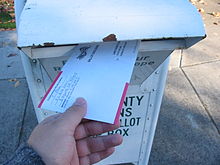Postal voting in the United States
[13][14][15][16][17] As of 2022, eight states – California, Colorado, Hawaii, Nevada, Oregon, Utah, Vermont, and Washington – allow all elections to be conducted by mail.
"[21] Motivated by false claims of widespread voter fraud in the 2020 election, Republican lawmakers initiated a push to roll back access to postal voting.
States that do not allow pre-processing—including Pennsylvania and Wisconsin—require officials to wait until Election Day to begin mail-in ballot verification and curing.
[55][56][57] The process extends traditional postal voting: the ballot is postal-mailed to a designated mailbox maintained by NASA, which sends it by encrypted electronic mail to the astronaut.
[63] For the 2018 elections, 14 counties were authorized to vote by mail and five ultimately did so: Madera, Napa, Nevada, Sacramento, and San Mateo.
[70] Nevada Governor Steve Sisolak (D) signed legislation authorizing mail-in-voting for every registered voter in the state on August 3, 2020.
[79] Vermont Governor Phil Scott signed that bill on June 7, 2021, and asked the legislature to expand all vote-by-mail to primary elections too.
[91] In 2018, Michigan passed Proposal 3, a state constitutional amendment legalizing "no-excuse" postal voting and other election reforms.
[92] In June 2023, the Connecticut legislature sent a ballot measure to the voters which, if passed in 2024, would amend the state constitution to allow no-excuse postal voting.
In September 2023, the New York Legislature passed a bill legalizing no-excuse absentee early voting up to nine days before an election or primary, which was signed into law by Governor Kathy Hochul.
... An additional six states [Michigan, Minnesota, Pennsylvania, Massachusetts, Missouri, and Alaska] not included on the table automatically send absentee/mail ballot applications to voters on a permanent list.
[95] In 2016, the US Government Accountability Office (GAO) issued a report outlining turnout improvements seen in vote by mail elections.
"[98] Postal ballots have been the source of "most significant vote-counting disputes in recent decades" according to Edward Foley, director of the Election Law program at Ohio State University.
Larger jurisdictions use computers to scan envelopes, quickly decide if the signature matches well enough, and set aside non-matches in a separate bin.
[137] Colorado accepts any signature that matches with respect to cursive v. printed, flowing v. slow and deliberate, overall spacing, size, proportions, slanted v. straight, spelling and punctuation.
[153] In the November 2016 general election, rejections ranged from none in Alabama and Puerto Rico, to 6% of ballots returned in Arkansas, Georgia, Kentucky and New York.
In the 2020 primary[158] and 2016 general[15] elections, Florida officials rejected 4% of postal ballots that claimed to come from voters aged 18–25.
The highest rejection rates for ballots that claimed to come from black voters were in Polk 17%, Taylor and Clay 16%, Putnam, and Warren 14%, Atkinson and Candler 13%, McIntosh 12%, and Glynn 10%.
Attorney Raul Macias has said, "Staff are under-trained, they're under-resourced, and they'll be under tremendous pressure to get results quickly and they're moving through thousands or millions of signatures."
They mention the extra security needed when voters send copies of identity documents to cure their signature rejection.
[137] California researchers recommended that the public needs easy access to see the signature on file before mailing in ballots, to further maximize matches.
This financial crisis has become more pressing amidst the coronavirus pandemic, as the $2 trillion economic stimulus package did not include money for the postal service.
[182] This means election day results can initially show a large Republican lead, or "red mirage", but mail-in ballots later demonstrate a Democratic victory.
[186] This asymmetry did not always exist, as in the 20th century, as recently as the 1996 United States presidential election, Republicans and Democrats were both able to cut their opponents' lead during the canvass period.
Foley conjectured that the 2002 passage of the Help America Vote Act accelerated the pronounced asymmetry of the blue shift phenomenon, because it required states to allow provisional ballots to be cast.
[186] He later found that the variation in the size of the blue shift is positively associated with the number of provisional ballots and the Democratic partisanship of the state in question.
[189] Oregon now has 300 drop boxes across the state in the weeks leading up to each election, and more voters now cast their ballot in person than by return mail.
[98][195] In July 2020, Trump suggested postponing the 2020 presidential election based on his unsubstantiated claims about extensive postal voting fraud.
[200] In September 2020, a federal judge issued an injunction against the recent USPS actions, ruling that Trump and DeJoy were "involved in a politically motivated attack on the efficiency of the Postal Service", adding that the 14 states requesting the injunction "demonstrated that this attack on the Postal Service is likely to irreparably harm the states' ability to administer the 2020 general election".
[203][verification needed] A March 2021 report from the Postal Service's inspector general found that the vast majority of mail-in ballots and registration materials in the 2020 election were delivered to the relevant authorities on time.









